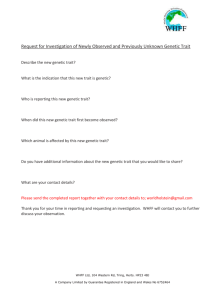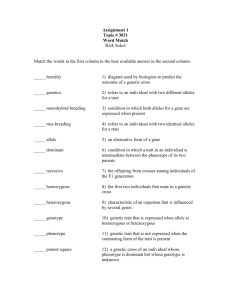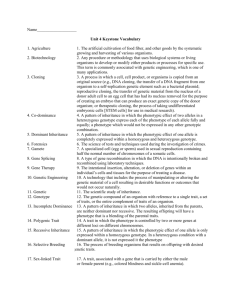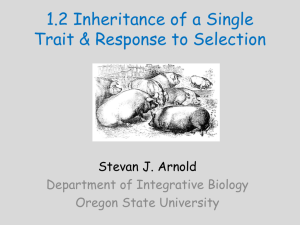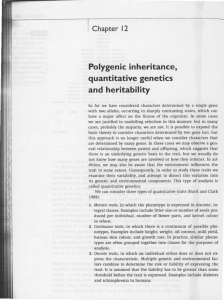Evolution of Phenotypic Traits
advertisement
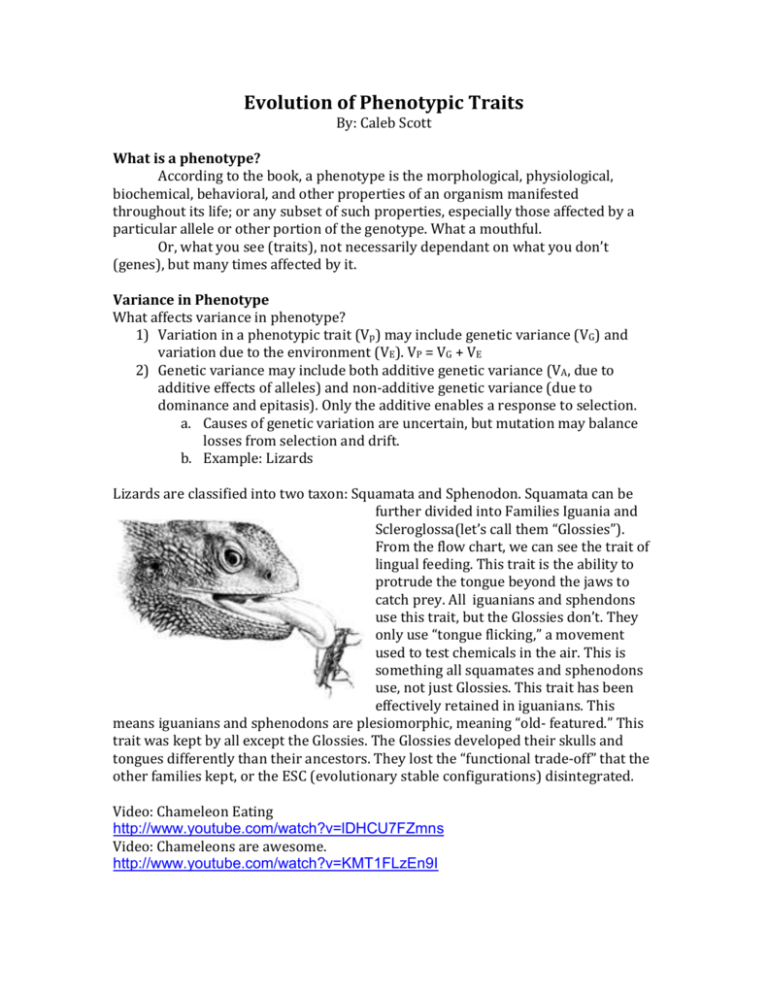
Evolution of Phenotypic Traits By: Caleb Scott What is a phenotype? According to the book, a phenotype is the morphological, physiological, biochemical, behavioral, and other properties of an organism manifested throughout its life; or any subset of such properties, especially those affected by a particular allele or other portion of the genotype. What a mouthful. Or, what you see (traits), not necessarily dependant on what you don’t (genes), but many times affected by it. Variance in Phenotype What affects variance in phenotype? 1) Variation in a phenotypic trait (Vp) may include genetic variance (VG) and variation due to the environment (VE). VP = VG + VE 2) Genetic variance may include both additive genetic variance (VA, due to additive effects of alleles) and non-additive genetic variance (due to dominance and epitasis). Only the additive enables a response to selection. a. Causes of genetic variation are uncertain, but mutation may balance losses from selection and drift. b. Example: Lizards Lizards are classified into two taxon: Squamata and Sphenodon. Squamata can be further divided into Families Iguania and Scleroglossa(let’s call them “Glossies”). From the flow chart, we can see the trait of lingual feeding. This trait is the ability to protrude the tongue beyond the jaws to catch prey. All iguanians and sphendons use this trait, but the Glossies don’t. They only use “tongue flicking,” a movement used to test chemicals in the air. This is something all squamates and sphenodons use, not just Glossies. This trait has been effectively retained in iguanians. This means iguanians and sphenodons are plesiomorphic, meaning “old- featured.” This trait was kept by all except the Glossies. The Glossies developed their skulls and tongues differently than their ancestors. They lost the “functional trade-off” that the other families kept, or the ESC (evolutionary stable configurations) disintegrated. Video: Chameleon Eating http://www.youtube.com/watch?v=lDHCU7FZmns Video: Chameleons are awesome. http://www.youtube.com/watch?v=KMT1FLzEn9I Heritability Heritability, h2, is the ratio VA/VP. What is heritable? Genotype and phenotype Environmental traits What about race in humans? o Two people from the same race can be much more genetically similar than two people from the same race o On average, individuals from different populations are just slightly more different that individuals from the same pop. o Still, medical implications of racial genetic differences are under debate. o Genetic analysis can distinguish groups of people according to their geographic origin. o People that have similar skin tones from different origins (i.e. subSahara and Australia) can be genetically very different. o Genetic racial realism: “If ‘race’ were a mere social construction based upon a few highly visible features, t would have no statistical correlation with the DNA markers that indicate genetic relatedness” – but is does. (Sarich and Miele) What about intelligence in humans? o A study shows that between 40 and 80% of variation in human IQ is attributable to genetic factors. o A genome scan for intelligence has revealed 2 regions with evidence of linkage…which supports the idea that trait variation within the “normal” range may be used to detect areas of mental retardedness, like autism and schizophrenia. Sources: http://icb.oxfordjournals.org/cgi/content/full/41/3/552 Bamshad, Michael J.; Olson, Steve E. Does Race Exist? Scientific American Journal, December 2003. Futuyma, Douglas J. Evolution, 2nd edition. Sinauer Associates, 2009. Glasgow, Joshua. A Theory of Race. Taylor and Francis 2009. Posthuma, Danielle, et. al. A Genomewide Scan for Intelligence Identifies Quantitative Trait Loci on 2q and 6p. Am. J. Hum. Genet. 77:318–326, 2005


